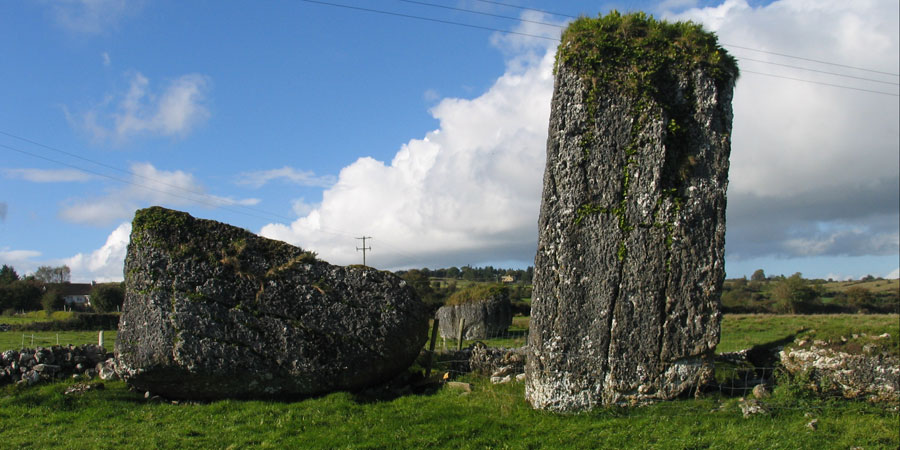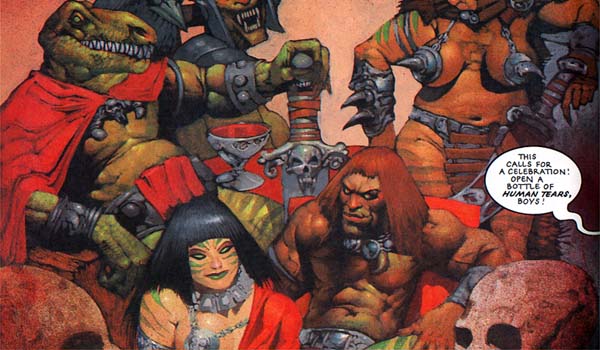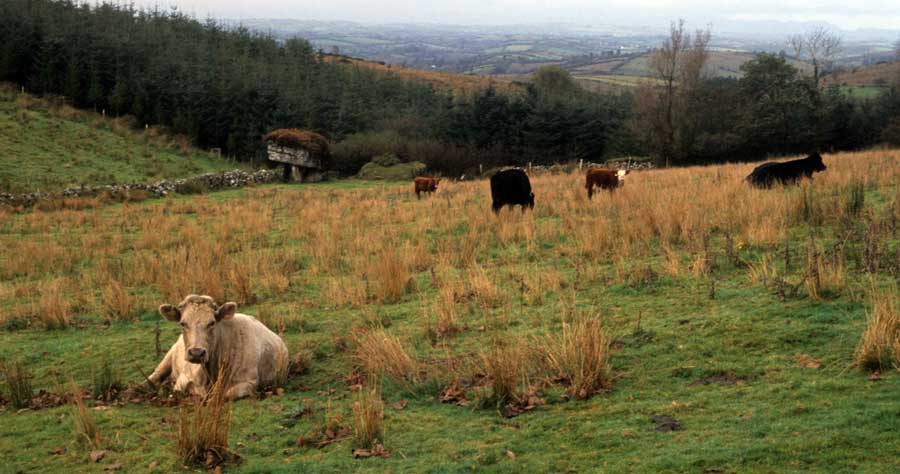The story of Moytura.
Many beautiful men fell there in the stall of death. Great was the slaughter and the grave-lying which took place there. Pride and shame were there side by side. There was anger and indignation. Abundant was the stream of blood over the white skin of young warriors mangled by the hands of bold men while rushing into danger for shame.
Harsh was the noise made by the multitude of warriors and champions protecting their swords and shields and bodies while others were striking them with spears and swords. Harsh too the tumult all over the battlefield—the shouting of the warriors and the clashing of bright shields, the swish of swords and ivory-hilted blades, the clatter and rattling of the quivers, the hum and whirr of spears and javelins, the crashing strokes of weapons.
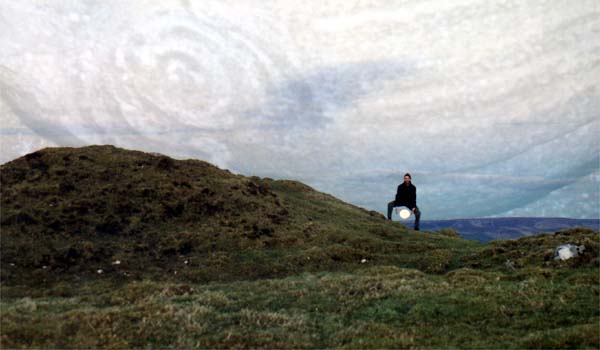
The Second Battle of Moytura is the central story, the jewel in the Crown of Irish mythology. It is a great epic wonder-tale of combat between the forces of Light and Darkness, good and evil, order and chaos, and yet at the same time it may well be an echo of two competeing groups of neolithic farmers who contested this landscape thousands of years ago.
The story was recorded in two versions in the sixteenth century; both of these, though they differ in some respects, follow the same thread which is thought to be based on a twelfth century manuscript. This in turn is known to be based on an ancient oral tradition which may well stretch back to the neolithic and beyond.
Few subjects have exercised our Irish antiquaries more than the battles of the two Moyturas. For that there were two Moytura battle-fields, one near Cong in county Mayo, called the southern Moytura, and the other in the parish of Kilmactrany in the county Sligo, called the northern Moytura,* seems to have been commonly admitted until Mr. W. M. Hennessy, in the preface to his edition of the Annals of Loch Ce, published in 1871, called in question the existence of the southern battlefield. As, however, the Mayo Moytura does not come within the scope of these pages, the writer has nothing to say to the difference between Mr. Hennessy and his brother antiquaries, which may one day develop into a new battle of Moytura, in which, as in the old one, giants are sure to be engaged.
* The Venerable Charles O'Conor writes thus in reference to this subject :—
"The Fomorians invited back the Belgians to their assistance, and their conjunction produced the second battle of Moy-turey, near the lake of Arrow ( Lough Arrow ), but distant from the former Moy-turey about fifty miles, and, by way of distinction, called Moyturey of the Fomorians. This place, surrounded by high hills, great rocks, and narrow defiles, was pitched upon, probably, by the weaker side, but which made the attack is not recorded."
— Dissertations on the History of Ireland, p. 167, Dublin, 1753.The history of Sligo: town and county,
Volume II
by T. O'Rorke, D. D., M. R. I. A., 1900.
There are several localised folklore versions of the Battles around the country, for example in north Sligo, Balor lived on Dernish Island instead of the more traditional Tory Island, while Eochy, King of the Firbolg was buried in Ballisodare instead of the massive cairn bearing his name in Ballinrobe. In much the same way, Queen Maeve's final resting place could be Rathmullen, Knocknarea or Knockma.
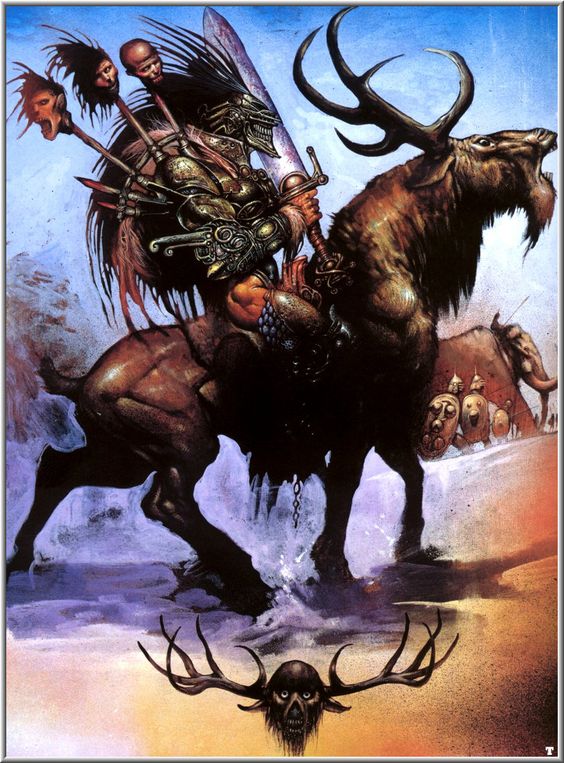
Lady Gregory's somewhat sanitized version in Gods and Fighting Men is easy to find and always in print. You can read the text online here.
There were two great mythological battles involving the Túatha Dé Danann which has given rise to some confusion, a few early writers have Northern Moytura taking place at Carrowmore in County Sligo, with the monuments being the graves of fallen warriors including the now lost Ecohy's cairn on Ballisodare strand.
Early dates from the causewayed enclosure at Mageraboy show colonists landing around the Cuil Iorra peninsula by 4,150 BC.
People acquainted with the literature of the Battle of Moytura may be disappointed at not finding here some reference to what Sir James Fergusson has written on the subject in his esteemed work on Rude Stone Monuments. No one has a better right than Sir James to be heard on such a subject, and the writer turned to his chapter on "Moytura" with a confident expectation of finding light in it, but was surprised to discover that the twelve pages and four illustrations, which Sir James thought he was devoting to the northern Moytura, were, every word and every line, given to Carrowmore in Coolerra, a place near twenty miles distant.
It is a great loss that, by the intervention of a putative Moytura, we are left in the dark as to the views of this sober, experienced, and able antiquary in regard to the real Moytura. However the extraordinary mistake may have occurred, it supplies one of the most striking instances, to be met with, of leaving Hamlet out of the play.
n appearance the plateau of Moytura is one of the most unattractive in Ireland—sombre, weird, and barren. Dull, however, as it looks, it commands a varied and picturesque prospect: all round, the mountains of Leitrim and Sligo; to the south, the rich and cultivated tract of Tir Tuathal; at various points, the lakes of Lough Bo, Lough na Suil, Lough Skean, Lough Ce, and Lough Arrow; and on the west, the sunny, smiling slopes of HoUybrook, backed up by the historic Dunaveeragh.
Can these myths be echoes and fragments of memories recalling prehistoric colonizations. The Dananns are said to have come to Ireland in magical ships, which they burned upon landing to show they had come to stay. An early version of the myth has them arriving at Lough Corrib in Co. Galway, sailing up the lake as far as Cong which is close to the site of the First Battle .
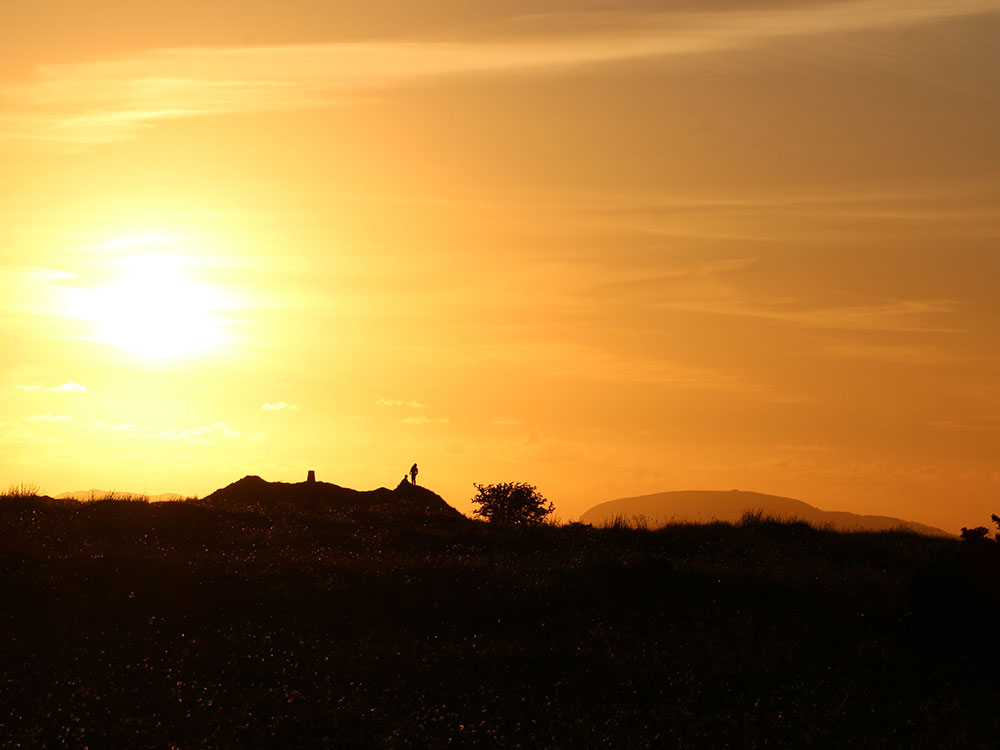
The other landing site was the hulking mountain of Sliabh an Iarann in Co Leitrim, which is not far to the east of Lough Arrow, the site of the Second Battle. If they landed on Sliabh an Iarann, they certainly must have had flying ships as it is quite a high mountain. Why not both landing sites - there is no reason why they might not have landed in two waves.

